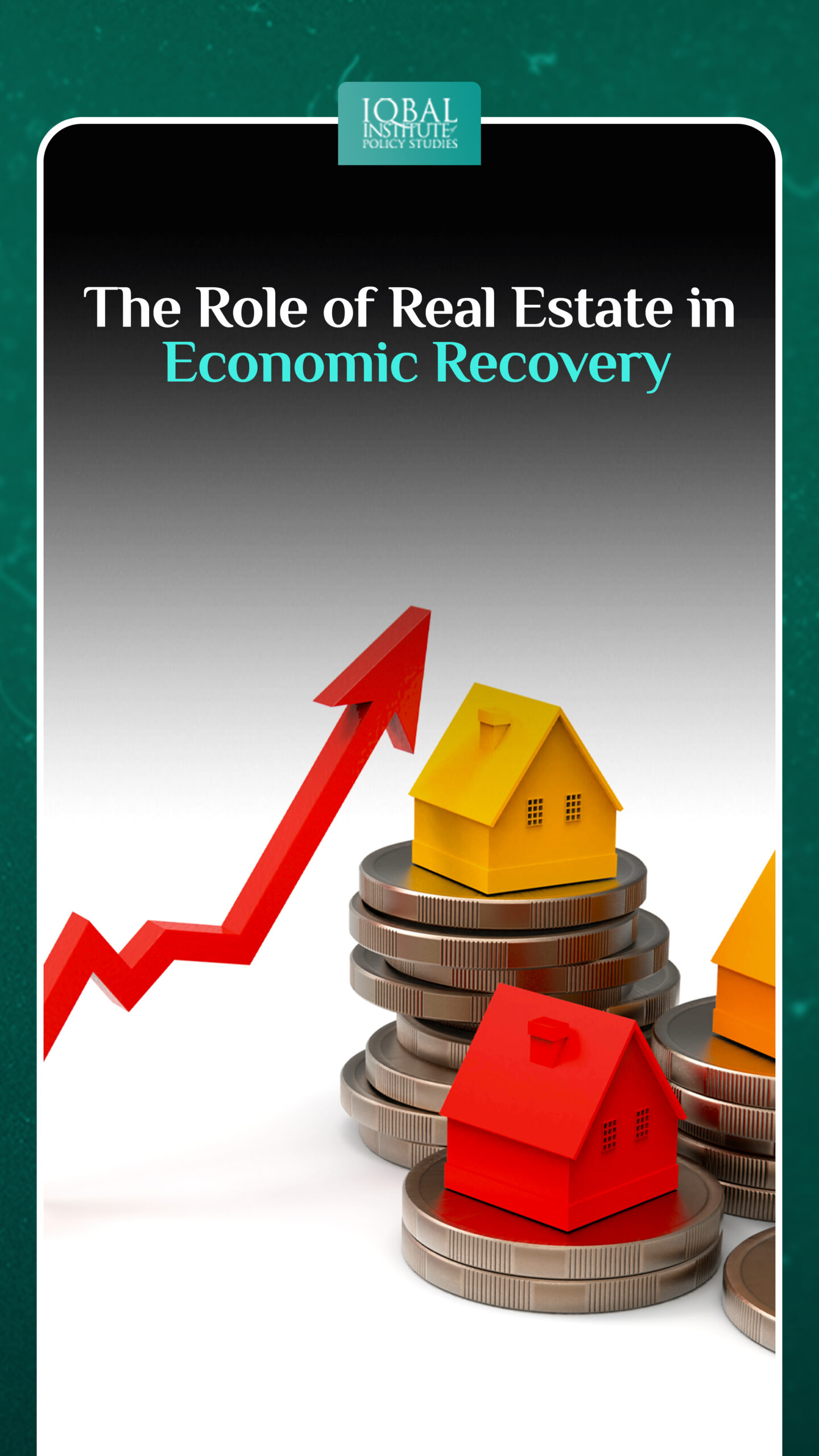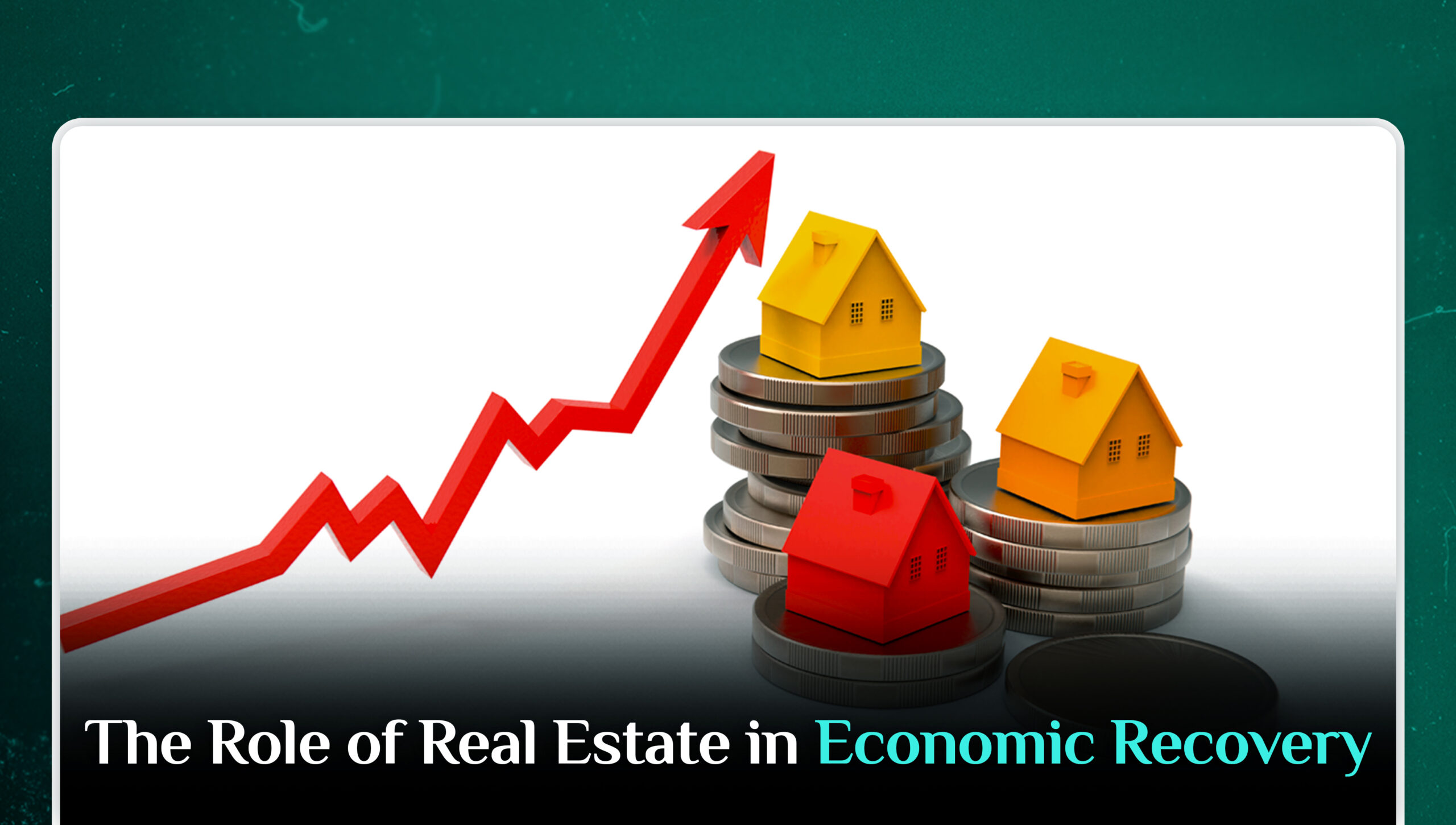Recovery from a recession is critical for any economy. A resilient and sustained economic recovery can contribute to long-term economic stability and prosperity. However, for developing nations like Pakistan, the global economic recovery is facing significant headwinds amid high inflation, political uncertainty and civil unrest. In such economic downturns, the real estate sector is a critical force driving economic recovery. This sector has a considerable impact on a variety of sectors, ranging from construction and manufacturing to banking and retail. It contributes towards growth and employment creation. Moreover, the allied businesses are stimulated by real estate activities like construction projects and infrastructure development, which create significant demand for materials, labour, and services. Also, real estate investments draw both domestic and foreign capital inflows, which promote economic resilience and financial stability. Thus, policymakers and stakeholders should take advantage of the real estate industry to boost economic growth, generate job opportunities, and fortify economies.
How Does it Help?
Employment Opportunities
The operations of real estate development, construction, and property management offer a diverse range of work opportunities. The sector employs people of all skill levels, from architects and engineers to construction workers and property managers. This increase in employment not only serves to lower unemployment rates but also encourages consumer spending and economic growth.
Economic Stimulation
Real estate transactions, such as purchasing, selling, and leasing properties, generate economic activity. They create income for real estate agents, brokers, and other relevant service providers, hence contributing to economic growth. Furthermore, real estate investments attract capital inflows, promoting financial stability and stimulating local economies.
Development of Infrastructure
Developing infrastructure, such as office buildings, apartment complexes, and public facilities, is a common part of real estate projects. Roads, utilities, and other necessary amenities must be built for these projects, which increases the demand for building supplies, labour, and other services. The ensuing infrastructural improvement not only boosts employment prospects but also the general standard of living in the region.
Income and Investment
Owning real estate and making investments generates income. Homeowners can acquire funding for other endeavours and build equity due to property appreciation. Additionally, real estate investment possibilities, such as real estate investment trusts (REITs), give investors a way to diversify their portfolios and make money, which helps the economy as a whole.
Tax Benefits
Government income and tax revenue are both significantly increased by the real estate industry. Government revenue is derived from property taxes, sales taxes on real estate transactions, and other associated levies. This income can be used to pay for social welfare programmes, public infrastructure projects, and other measures that support economic growth and recovery. Moreover, real estate tax breaks and refunds are designed to put more money in the hands of customers. The ideal case for these clients is to spend some of their money at different businesses, increasing their revenues, cash flows, and profits. More money allows businesses to raise capital, enhance innovations, expand, and flourish. All of these activities promote productivity, which leads to higher economic growth. Tax breaks and refunds encourage customers to spend more money, which helps the economy.
Supports Industries and Businesses
Associated industries are affected by the real estate market. The demand for legal services, title insurance, building supplies, and furniture, for instance, rises as a result of real estate transactions and development. Small enterprises and entrepreneurial endeavours are supported by these activities, which further boosts local economies.
Funding and loan
The real estate industry is strongly reliant on lending and financing institutions. Banks and financial institutions play an important role in mortgage lending, construction financing, and real estate development funding. These institutions promote real estate transactions, construction projects, and property investments by allowing access to finance, thereby contributing to economic recovery.
How is Real Estate Helping the Economy of Pakistan?
Real estate is a key economic industry that has contributed greatly to Pakistan’s development. This industry is currently valued at more than $3 trillion (Haq, 2022). The State Bank of Pakistan (SBP) estimated that in 2021, the real estate industry made up about 2% of Pakistan’s GDP (PIDE, 2023). This sector’s output enables economic activity in the country, broadening its horizons across all sectors. For instance, it promotes demand in over 400 industries ranging from construction (cement, steel, paint, building materials, architects, and urban planners) to financial services. Also, after agriculture, it is Pakistan’s second greatest source of employment. (Fraz, 2021).
According to the World Bank, real estate industry assets comprise 60-70 per cent of the country’s wealth, or around USD 300-400 billion (Fraz, 2021). Real estate comprises almost 200 distinct businesses (Qazi Investments, 2021). Furthermore, real estate activities account for 18 per cent of the Private Sector Gross Fixed Capital Formation (GFCF), 9.6% of services and 5.6% of GDP (PAKISTAN ECONOMIC SURVEY 2021-22, 2022). However, the question remains whether or not the real estate industry can help Pakistan in economic recovery.
If we take the example of the United Arab Emirates, which has had an exceptional economic expansion, fueled primarily by the real estate sector. The development of ambitious projects drew global investment and established the UAE as a booming commercial and tourism destination. The UAE’s real estate boom also resulted in economic diversification, employment creation, and significant contributions to GDP. The UAE will soon surpass Saudi Arabia as the top in the Gulf Cooperation Council (GCC) real estate industry, with an estimated 21.6% market share. Moreover, the UAE’s property market accounts for around 5.5% of the country’s GDP, with a rising tendency since 2022 (Tarraf, 2023). The government’s aggressive approach to encouraging foreign investment is one of the reasons why the UAE’s real estate sector has been so successful.
Pakistan’s real estate industry too can help the country’s dwindling economy if the government takes effective measures. For instance, less than 0.5% of Pakistan’s land is planned, with an estimated cost of USD 600 to 700 billion. If 20 million new homes are built by 2040, the value of this projected region might rise to USD 1.5 to 2 trillion. It will also result in the creation of 15 to 20 million jobs in real estate and related industries (Aijaz, 2022). With a continued focus on creating an enabling environment for real estate investment, addressing regulatory challenges, and implementing supportive policies, the sector can help revive the economy of Pakistan.
Conclusion
The importance of real estate in economic recovery cannot be overstated. This sector’s ability to create jobs, promote economic activity, attract investments, and contribute to infrastructure development, makes it an essential component of any recovery strategy. Governments and stakeholders can speed economic recovery, support sustainable growth, and lay a firm foundation for long-term prosperity by exploiting the potential of the real estate industry.
References
Aijaz, U. (2022, March 14). Economics of real estate in Pakistan. Retrieved from Pakistan and Gulf Economist: https://www.pakistangulfeconomist.com/2022/03/14/economics-of-real-estate-in-pakistan/
Fraz, A. (2021, January 30). Real Estate Myths in Pakistan and the Truth Behind Them. Retrieved from PIDE Blogs: https://pide.org.pk/blog/real-estate-myths-in-pakistan-and-the-truth-behind-them/
Haq, S. (2022, November 18). Real estate in development phase. Retrieved from The Express Tribune: https://tribune.com.pk/story/2386882/real-estate-in-development-phase
PAKISTAN ECONOMIC SURVEY 2021-22. (2022). REAL ESTATE HIGHLIGHTS. Retrieved from naphda: https://naphda.gov.pk/naphda.gov.pk/docs/Economy%20Survey%20-%20Real%20Estate%20Highlights.pdf
Pakistan Institute of Development Economics. (2023, March 19). Size, Trend, and Challenges in Real Estate of Pakistan. Retrieved from LinkedIn: https://www.linkedin.com/pulse/size-trend-challenges-real-estate-pakistan
Qazi Investments. (2021, April 15). Role of Real Estate Sector in Pakistan’s Economic Growth. Retrieved from https://qaziinvestments.com/role-of-real-estate-sector-in-pakistans-economic-growth/
real4expo. (2022, October). PAKISTAN REAL ESTATE IN NUMBERS. Retrieved from https://real4expo.com/about
Tarraf, S. B. (2023, April 25). The real estate market in the UAE is a leading growth sector. Retrieved from LinkedIn: https://www.linkedin.com/pulse/real-estate-market-uae-leading-growth-sector-suhail-bin-tarraf#:~:text=A%20growth%20sector%20core%20to%20UAE’s%20economic%20diversification&text=The%20sector%20has%20been%20a,in%20rentals%20and%20property%20prices.



Leave a Reply